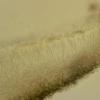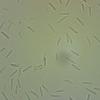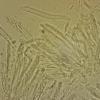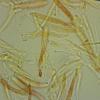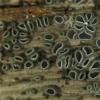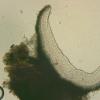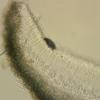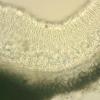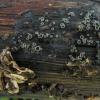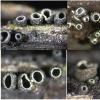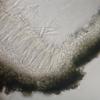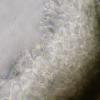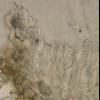
12-11-2025 09:25
 Viktorie Halasu
Viktorie Halasu
Hello, I need help with a pale terrestric Pseudom

11-11-2025 20:16
Bohan JiaHi, lastly I have found these tiny yellow decayin

09-11-2025 13:20
Hello.A tiny ascomycete, appearing as erupting gra

08-11-2025 00:29
 Francois Guay
Francois Guay
I found this species in Quebec, Canada, on herbace
Mollisia ? Tapesia ?
Gilles Corriol,
26-04-2013 11:36
 Un autre dans les Dermataceae cette fois. GC13042106
Un autre dans les Dermataceae cette fois. GC13042106Très abondant à la base de tiges mortes d'Angelica sylvestris.
Un subiculum noir semble présent occasionnellement (voir photo ascomes avec ou sans).
Apothécies cupuliformes, 0,4-1 mm, en troupes denses, sessiles, à hyménium gris foncé et marge blanchâtre fortement incurvée.
Spores 7,9-10,2 x 1,8-2,4 µm, fusiformes, à très faibles et petites gouttes polaires.
Asques environ 55 x 6 µm, bisériés, bouclés, I+ (lugol).
Paraphyses cylindriques, non réactives dans KOH 5%.
Excipulum à textura prismatica, puis excipulum ectal à textura globulosa, fortement pigmenté de brun foncé.
Avec quelle biblio pourrais-je tenter de déterminer ce champignon ?
Merci !
Hans-Otto Baral,
26-04-2013 11:40

Re : Mollisia ? Tapesia ?
Clearly a Pyrenopeziza. I use to identify such records as P. atrata.
Zotto
Zotto
Gilles Corriol,
27-04-2013 10:19

Re : Mollisia ? Tapesia ?
I find P. atrata neither in any key, nor in your DVD Zotto ?
With the key from B. Declercq, I fall close to P.pulveracea which is given from Filipendula stems.
In my place, there were Angelica sylvestris and Filipendula ulmaria mixted. The Pyrenopeziza was almost on every Angelica stem and none on Filipendula stems.
How should I know that my fungus belongs to the genus Pyrenopeziza ?
Thank you !
Gilles
With the key from B. Declercq, I fall close to P.pulveracea which is given from Filipendula stems.
In my place, there were Angelica sylvestris and Filipendula ulmaria mixted. The Pyrenopeziza was almost on every Angelica stem and none on Filipendula stems.
How should I know that my fungus belongs to the genus Pyrenopeziza ?
Thank you !
Gilles
Hans-Otto Baral,
27-04-2013 10:32

Re : Mollisia ? Tapesia ?
P. pulveracea (and fuscostriata) is a smaller fungus (usually <0.5 mm) with permanently urceolate apothecia with more protruding margin, but the variability seems rather high.
P. pulveracea is usually distinctly erumpent from beneath the epidermis, a typical character of Pyrenopeziza.
P. atrata goes over 1 mm and looks somewhat like Mollisia cinerea. And yes, the species is almost never reported. I only know the report by Huhtinen ("Huhtinen 1985, Pyrenopeziza atrata-1.JPG, -2.JPG", see on the uploaded DVD). There you also find a lot of photos of the common species. No idea how Bernard would identify this.
From Mollisia this is usually sharply delimited by the absence of VBs in the paraphyses, though I saw low-refractove VBs also here sometimes (HB 8854, 8571b). Would be a matter for sequencing (hope Andreas is reading this).
Zotto
P. pulveracea is usually distinctly erumpent from beneath the epidermis, a typical character of Pyrenopeziza.
P. atrata goes over 1 mm and looks somewhat like Mollisia cinerea. And yes, the species is almost never reported. I only know the report by Huhtinen ("Huhtinen 1985, Pyrenopeziza atrata-1.JPG, -2.JPG", see on the uploaded DVD). There you also find a lot of photos of the common species. No idea how Bernard would identify this.
From Mollisia this is usually sharply delimited by the absence of VBs in the paraphyses, though I saw low-refractove VBs also here sometimes (HB 8854, 8571b). Would be a matter for sequencing (hope Andreas is reading this).
Zotto
Michel Hairaud,
27-04-2013 17:28

Re : Mollisia ? Tapesia ?
Bonjour Gilles et Zotto, et tous.
Très heureux de te voir t'adonner à l'étude des Helotiales ainsi, Gilles ! C'est le début de l'époque faste pour les Pyrenopeziza sur toutes sortes de plantes, tu n'es pas au bout du plaisir...
Je joins un montage d'images de P. pulveracea que je viens de récolter, justement, sur des tiges de menthe, d'une largeur maxi de 0,7 mm pour cette récolte. Il reste souvent, sur les apothécies naissantes, des restes du derme de la plante comme le souligne Zotto. Cette espèce n'est pas rare à mon avis sur différents supports.
J'avais l'impression que ta récolte était très proche , les apothécies sont aussi bien cupulées et les spores de taille et d'indice de guttulation très semblables.
QUand j'ai des doutes entre les genres Pyrenopeziza et Mollisia, je parviens en général à trancher grâce au bleu de crésyl qui ne donne pas, selon mon expérience, les mêmes résultats sur les masses peu réfringentes des paraphyses (VBs ?) des Pyrenpeziza la belle coloration bleu-vert et homogène des VBs des Mollisia.
Mais j'avoue que les vacuoles HB 8854, et 8571b sont troublantes .
Amitiés
Michel
Très heureux de te voir t'adonner à l'étude des Helotiales ainsi, Gilles ! C'est le début de l'époque faste pour les Pyrenopeziza sur toutes sortes de plantes, tu n'es pas au bout du plaisir...
Je joins un montage d'images de P. pulveracea que je viens de récolter, justement, sur des tiges de menthe, d'une largeur maxi de 0,7 mm pour cette récolte. Il reste souvent, sur les apothécies naissantes, des restes du derme de la plante comme le souligne Zotto. Cette espèce n'est pas rare à mon avis sur différents supports.
J'avais l'impression que ta récolte était très proche , les apothécies sont aussi bien cupulées et les spores de taille et d'indice de guttulation très semblables.
QUand j'ai des doutes entre les genres Pyrenopeziza et Mollisia, je parviens en général à trancher grâce au bleu de crésyl qui ne donne pas, selon mon expérience, les mêmes résultats sur les masses peu réfringentes des paraphyses (VBs ?) des Pyrenpeziza la belle coloration bleu-vert et homogène des VBs des Mollisia.
Mais j'avoue que les vacuoles HB 8854, et 8571b sont troublantes .
Amitiés
Michel
Hans-Otto Baral,
27-04-2013 17:44

Re : Mollisia ? Tapesia ?
Maybe, Gillet, sorry, Gilles, you could solve the problem by keeping the find in a moist box for some days. When the apos get more flat and even larger than 1 mm then I think it is P. atrata.
Zotto
Zotto
Gilles Corriol,
28-04-2013 16:50

Re : Mollisia ? Tapesia ?
Merci Michel pour ton aide et ton encouragement. Je note la réaction au Crésyl.
Actually, I kept some living material. Overmature apothecia become almost flat and reach one milimeter. Isn't it a week character ?
I keep nevertheless the name P. atrata. Thank you Zotto.
Actually, I kept some living material. Overmature apothecia become almost flat and reach one milimeter. Isn't it a week character ?
I keep nevertheless the name P. atrata. Thank you Zotto.
Hans-Otto Baral,
28-04-2013 18:10

Re : Mollisia ? Tapesia ?
It may be a week character, but I suppose that pulveracea will never get such flat and large when you keep it in the box. Some species have little differences, and in addition some variation.
Zotto
Zotto
Michel Hairaud,
28-04-2013 18:48

Re : Mollisia ? Tapesia ?
Hi Zotto and Gilles,
I am pleased to discover also this taxon and with this feature making a macro difference to observe. I guess a correspondance could be noticed in the excipulum structure. As P. atrata should be common in Le Marais Poitevin on Angelica stems, I will try to find something on living material.
Looking again to Gilles'transect , a diffrence in the margin elevation can be easily noticed : it seems that P. atrata's hymenium stretches up to the margin end whereas in P. pulveracea the whole height over the hymenium looks sterile (as in Pirottaea) .
Here are 2 micro pics fromP. pulveracea for illustration
Merci les gars !
Michel
I am pleased to discover also this taxon and with this feature making a macro difference to observe. I guess a correspondance could be noticed in the excipulum structure. As P. atrata should be common in Le Marais Poitevin on Angelica stems, I will try to find something on living material.
Looking again to Gilles'transect , a diffrence in the margin elevation can be easily noticed : it seems that P. atrata's hymenium stretches up to the margin end whereas in P. pulveracea the whole height over the hymenium looks sterile (as in Pirottaea) .
Here are 2 micro pics fromP. pulveracea for illustration
Merci les gars !
Michel
Hans-Otto Baral,
28-04-2013 19:10

Re : Mollisia ? Tapesia ?
Yes, Michel, I was also thinking this, but the only image I have is not very convincing.
This one (HB 8490b) looks quite different from yours, and it was first taken for Olla ulmariae!
But P. atrata is on every previous year's stem of big Apiaceae, Cirsium, Arctium, Epilobium etc., still standing, at the base.
Zotto
This one (HB 8490b) looks quite different from yours, and it was first taken for Olla ulmariae!
But P. atrata is on every previous year's stem of big Apiaceae, Cirsium, Arctium, Epilobium etc., still standing, at the base.
Zotto
Michel Hairaud,
28-04-2013 20:00

Re : Mollisia ? Tapesia ?
I once read somewhere, : ... '' and in addition, some variation''
but forgot which Master wrote it :-)
Michel
but forgot which Master wrote it :-)
Michel
Hans-Otto Baral,
28-04-2013 20:32

Re : Mollisia ? Tapesia ?
I am not sure whether this all is the same, and nigrostriata also only a variant. Who knows. The resemblance to Olla was also striking, and I remember some pale brown excipulum in some Olla specimens. Maybe only convergence.
Michel Hairaud,
28-04-2013 21:05

Re : Mollisia ? Tapesia ?
Are there Olla species whithout glassy hairs ?
Michel
Michel
Hans-Otto Baral,
28-04-2013 21:14

Re : Mollisia ? Tapesia ?
No, but I once had the idea of Microscypha arenula to be an Urceolella without glassy hairs. Now I am not sure till today if that is true or it is a Pyrenopeziza instead.
Zotto
Zotto
Gilles Corriol,
29-04-2013 09:05

Re : Mollisia ? Tapesia ?
Yes, I confirm Michel that in my collection the hymenium comes up to the margin.
What about the importance (or not) of the black subiculum on Pyrenopeziza species ?
What about the importance (or not) of the black subiculum on Pyrenopeziza species ?
Hans-Otto Baral,
29-04-2013 09:09

Re : Mollisia ? Tapesia ?
I remember thinner and hyaline to pale olivebrown hyphae in Pyrenopeziza, never forming a subiculum extending over the substrate.
Zotto
Zotto
